The Gilpin Tram in Black Hawk
Posted by Keith Pashina on Feb 20, 2023; 11:29pm
URL: http://c-sng-discussion-forum.254.s1.nabble.com/The-Gilpin-Tram-in-Black-Hawk-tp18436.html
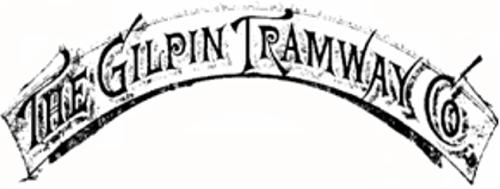
The Gilpin Tram in Black Hawk
I think the Gilpin Tram (for simplicity, I will refer to both the Gilpin Tramway Company and successor Gilpin Railroad by this term) trackage, facilities, industries and operations in Black Hawk are fascinating subjects that deserve a closer look. In some ways, this area is so much unlike other narrow gauge locations, because of the concentration of industries, homes and retail buildings all crowded together, in a bit over a mile in Clear Creek canon. The feel here is more like a big city industrial area. For the modeler, there is a lot here to like. Mill structures vary from narrow to wide, walls of stone, metal and wood, mill buildings with sloping roofs, flat roofs and combinations thereof. Trackage in town includes two foot and three foot gauge, and extensive dual gauge and the trackwork bridges crosses Clear Creek and its tributaries numerous times.
The Colorado Central was built to serve the rich mining towns of Black Hawk, Central City, and satellite towns, following rich gold strikes beginning in the 1850s. However, by the 1880s, the mining district was hurting. Operations had evolved from capturing the easy-to-reach gold in placers and shallow shafts and tunnels, to having to mine more complex ores at greater and greater depths. The mining districts began reconstructing shaft houses with more technically advanced and larger hoists and equipment.
But, even though there was plenty of ore to claim, their gold, silver, and other metals content tended to be lower. The plentiful, but lower-value ore meant more ore shipped to the mills, but their lowered value increased costs, and strained the capabilities of the local teamsters to haul it. Even worse, the ores at greater depths became more complex in their mineralization, meaning the formerly productive milling techniques no longer were capturing much of the gold and silver in the ores – more and more was going out the launders into the tailings dumps. The district was declining, and things would get worse, unless these issues could be overcome. Fortunately, advances in milling and smelting methods found ways to get most of the values from the ores, and mining was rejuvenated and expanded rapidly.
As luck would have it, another technical marvel was available to help develop the Gilpin County mines – a very narrow gauge tramway. The 2’ gauge Gilpin Tramway was constructed to serve the local mines and mills in Gilpin County. The mines needed coal and assorted supplies hauled in, and the mills received the ores for further processing. The tramway was able to very economically haul the lower-valued ores to the mills. Almost all of this traffic either originated or terminated in Black Hawk.
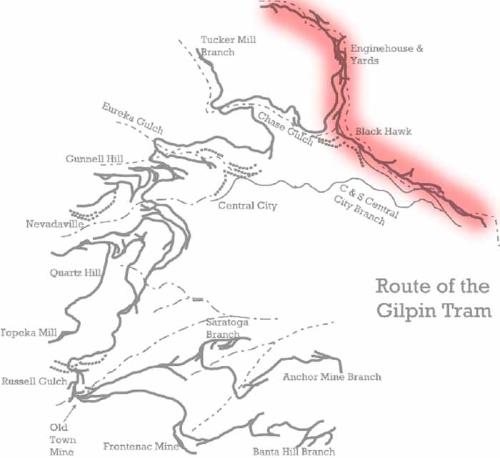
The red-shaded area shows the Black Hawk area
The Gilpin Tramway (and beginning in 1906, the Gilpin Railroad after the C&S purchase) based its operations in Black Hawk, and served the many mills through a network of spurs and dual-gauge trackage. There was a freight transfer, too, where coal and other supplies were received from the Colorado Central/C&S, and ore shipped out to mills and smelters not located in Black Hawk.
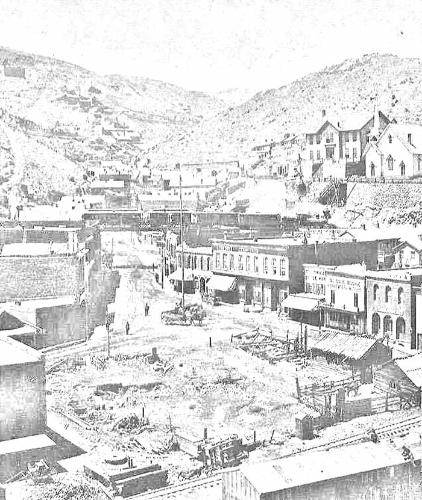
Black Hawk has a lot of interesting features that make for great modeling subjects: 2 narrow gauges, interesting structures, all crowded into narrow mountain valleys
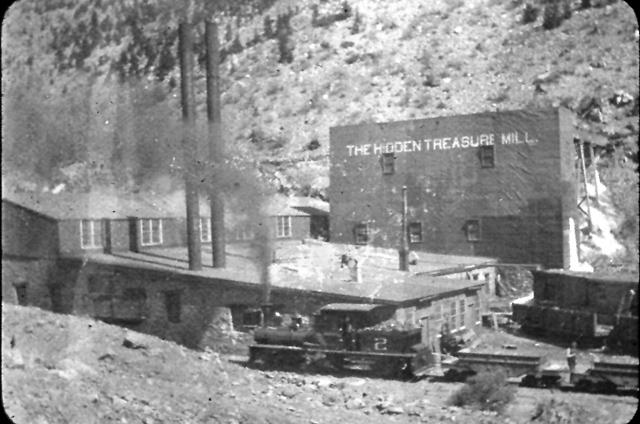
Shay #2 is pulling empty ore cars back to the Black Hawk yards, chuffing past the Hidden Treasure Mill. This mill was also directly served by the tram
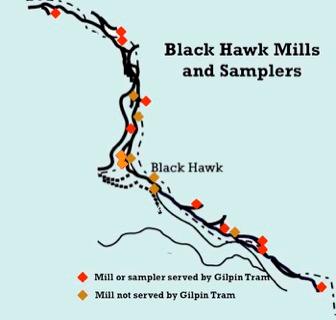
A map showing the locations of the mills, sampling works, and concentrators in Black Hawk
The Gilpin Tram Warming House
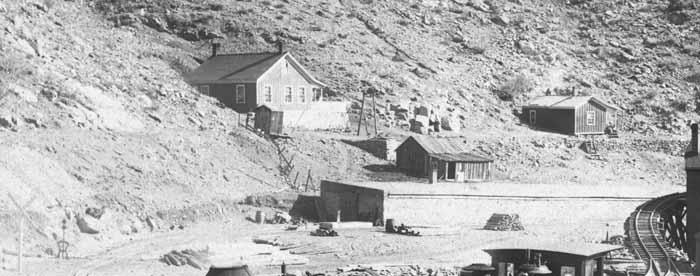
The Gilpin Tram’s warming house only appears in a few photos. This enlargement of a photo in the Denver Public Library, Western History Collection (image Z-187) shows the warming house
This is an enlargement from a photo in the Denver Public Library collection, and shows the north end of the warming house. A harp switch stand for the lead track to the warming house can be seen by the left margin (next to the railroad crossing sign for the wagon road). There are ties and barrels stored by the warming house. The track enters what appears to be a wooden sliding door, where inside, the track branched out into three parallel sidings
Across Clear Creek from the engine house, the Gilpin Tram built a stone warming house. This structure was need to provide a place for loaded ore cars to be parked and warmed until the ore loads thawed. The gold-bearing ores tended to be mined in wet conditions, so during winter months, the ore often froze up. By parking the loaded ore cars overnight, or for several hours in a heated structure, the loads would thaw, and then be taken to the various mills to be dumped into the ore bins.
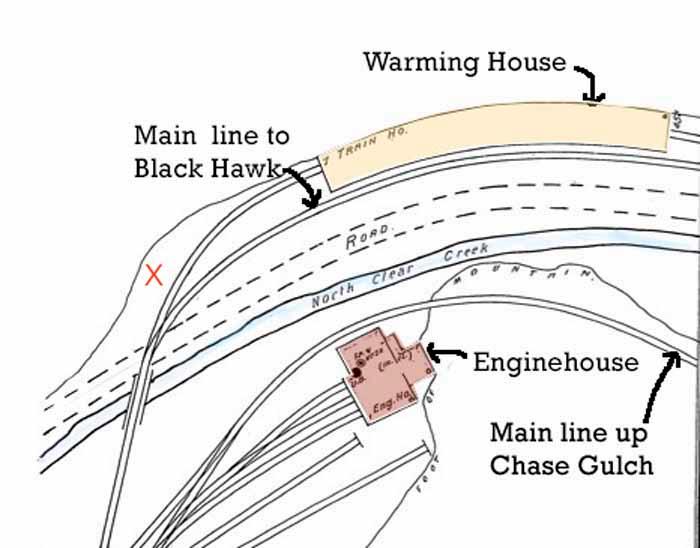
The Gilpin Tram’s enginehouse area. The warming house was on the east side of Clear Creek. The red “X” shows the location of the possible water tank discussed in the thread, “Speculation on the Gilpin Tramway at the Black Hawk Roundhouse” begun by Chris Walker on February 2, 2023.
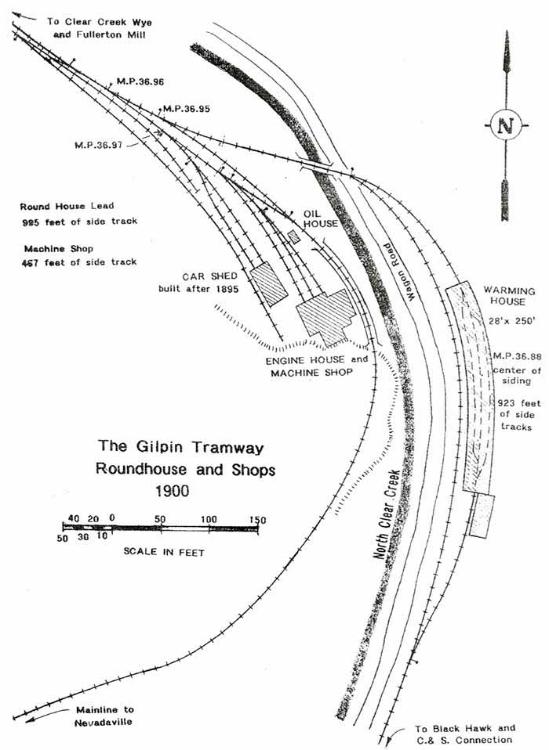
This map was drawn by Dan Abbott, and originally published in Issue 4 of the Gilpin Railroad Historical Society Newsletter. A similar map of Dan's was also published on page 33 of the book, The Gilpin Railroad Era.
Dan's research shows the mainline down into Black Hawk passing by the stone structure, next to the creek. Dan's research showed the building eventually measured 28' wide by 250' long, and had three tracks inside. I think this structure was modified quite a bit over the years. Originally, the building was heated by a series of stoves, but later, a large boiler was set up, and fed steam pipes throughout the building. The small structure addition on the south end may be a boiler house.
This structure was located on a sloping grade, so the loaded ore cars would be dropped by gravity into the north end of the building, and on to one of the three interior tracks. In the morning, the now-thawed cars would be carefully dropped down onto the main spur on the south side of the warming house, to be picked up and switched by one of the shays. The building was too low for locomotives to go inside.
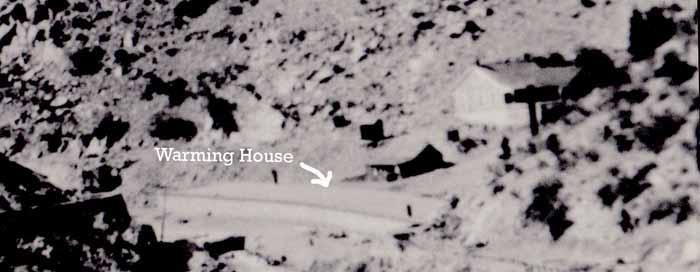
Photos of the warming house are rare, and it appears in the background in only a few older photos. This is another enlargement of a Denver Public Library, Western History Collection photo, and shows a (distant) overall view of the warming house. There are two houses next to the engine house.
On the far right (north side), there is a large structure of some size. I thought this was an ore bin for a nearby mine, but Chris Walker’s recent thread here indicated this could possibly be a squarish water tank.
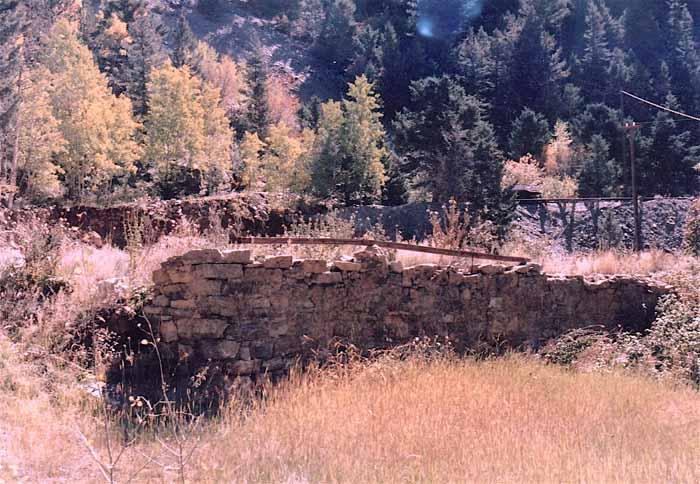
By the 1980s, not much remained of the warming house, except for a few stone walls on the north end of the structure. These were later buried under dirt fill for construction of a parking lot.
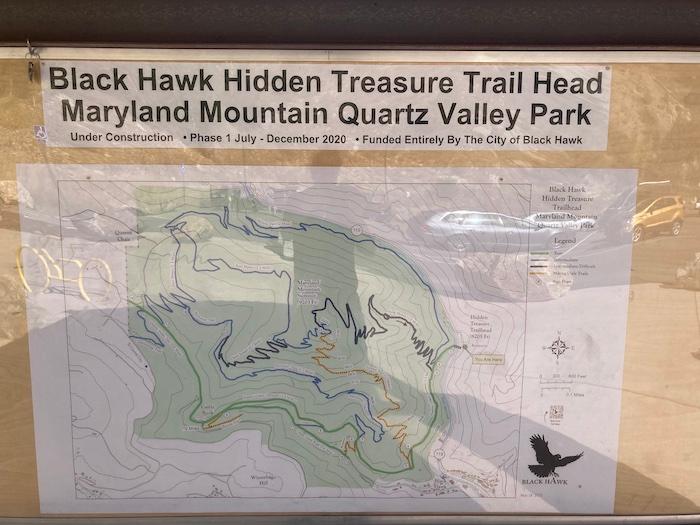
The former Gilpin Tram mainline up Chase Gulch has been turned into a regional trail for hikers and mountain bikers. The trailhead, next to Highway 119, is on the former site of the warming house
URL: http://c-sng-discussion-forum.254.s1.nabble.com/The-Gilpin-Tram-in-Black-Hawk-tp18436.html

The Gilpin Tram in Black Hawk
I think the Gilpin Tram (for simplicity, I will refer to both the Gilpin Tramway Company and successor Gilpin Railroad by this term) trackage, facilities, industries and operations in Black Hawk are fascinating subjects that deserve a closer look. In some ways, this area is so much unlike other narrow gauge locations, because of the concentration of industries, homes and retail buildings all crowded together, in a bit over a mile in Clear Creek canon. The feel here is more like a big city industrial area. For the modeler, there is a lot here to like. Mill structures vary from narrow to wide, walls of stone, metal and wood, mill buildings with sloping roofs, flat roofs and combinations thereof. Trackage in town includes two foot and three foot gauge, and extensive dual gauge and the trackwork bridges crosses Clear Creek and its tributaries numerous times.
The Colorado Central was built to serve the rich mining towns of Black Hawk, Central City, and satellite towns, following rich gold strikes beginning in the 1850s. However, by the 1880s, the mining district was hurting. Operations had evolved from capturing the easy-to-reach gold in placers and shallow shafts and tunnels, to having to mine more complex ores at greater and greater depths. The mining districts began reconstructing shaft houses with more technically advanced and larger hoists and equipment.
But, even though there was plenty of ore to claim, their gold, silver, and other metals content tended to be lower. The plentiful, but lower-value ore meant more ore shipped to the mills, but their lowered value increased costs, and strained the capabilities of the local teamsters to haul it. Even worse, the ores at greater depths became more complex in their mineralization, meaning the formerly productive milling techniques no longer were capturing much of the gold and silver in the ores – more and more was going out the launders into the tailings dumps. The district was declining, and things would get worse, unless these issues could be overcome. Fortunately, advances in milling and smelting methods found ways to get most of the values from the ores, and mining was rejuvenated and expanded rapidly.
As luck would have it, another technical marvel was available to help develop the Gilpin County mines – a very narrow gauge tramway. The 2’ gauge Gilpin Tramway was constructed to serve the local mines and mills in Gilpin County. The mines needed coal and assorted supplies hauled in, and the mills received the ores for further processing. The tramway was able to very economically haul the lower-valued ores to the mills. Almost all of this traffic either originated or terminated in Black Hawk.

The red-shaded area shows the Black Hawk area
The Gilpin Tramway (and beginning in 1906, the Gilpin Railroad after the C&S purchase) based its operations in Black Hawk, and served the many mills through a network of spurs and dual-gauge trackage. There was a freight transfer, too, where coal and other supplies were received from the Colorado Central/C&S, and ore shipped out to mills and smelters not located in Black Hawk.

Black Hawk has a lot of interesting features that make for great modeling subjects: 2 narrow gauges, interesting structures, all crowded into narrow mountain valleys

Shay #2 is pulling empty ore cars back to the Black Hawk yards, chuffing past the Hidden Treasure Mill. This mill was also directly served by the tram

A map showing the locations of the mills, sampling works, and concentrators in Black Hawk
The Gilpin Tram Warming House

The Gilpin Tram’s warming house only appears in a few photos. This enlargement of a photo in the Denver Public Library, Western History Collection (image Z-187) shows the warming house
This is an enlargement from a photo in the Denver Public Library collection, and shows the north end of the warming house. A harp switch stand for the lead track to the warming house can be seen by the left margin (next to the railroad crossing sign for the wagon road). There are ties and barrels stored by the warming house. The track enters what appears to be a wooden sliding door, where inside, the track branched out into three parallel sidings
Across Clear Creek from the engine house, the Gilpin Tram built a stone warming house. This structure was need to provide a place for loaded ore cars to be parked and warmed until the ore loads thawed. The gold-bearing ores tended to be mined in wet conditions, so during winter months, the ore often froze up. By parking the loaded ore cars overnight, or for several hours in a heated structure, the loads would thaw, and then be taken to the various mills to be dumped into the ore bins.

The Gilpin Tram’s enginehouse area. The warming house was on the east side of Clear Creek. The red “X” shows the location of the possible water tank discussed in the thread, “Speculation on the Gilpin Tramway at the Black Hawk Roundhouse” begun by Chris Walker on February 2, 2023.

This map was drawn by Dan Abbott, and originally published in Issue 4 of the Gilpin Railroad Historical Society Newsletter. A similar map of Dan's was also published on page 33 of the book, The Gilpin Railroad Era.
Dan's research shows the mainline down into Black Hawk passing by the stone structure, next to the creek. Dan's research showed the building eventually measured 28' wide by 250' long, and had three tracks inside. I think this structure was modified quite a bit over the years. Originally, the building was heated by a series of stoves, but later, a large boiler was set up, and fed steam pipes throughout the building. The small structure addition on the south end may be a boiler house.
This structure was located on a sloping grade, so the loaded ore cars would be dropped by gravity into the north end of the building, and on to one of the three interior tracks. In the morning, the now-thawed cars would be carefully dropped down onto the main spur on the south side of the warming house, to be picked up and switched by one of the shays. The building was too low for locomotives to go inside.

Photos of the warming house are rare, and it appears in the background in only a few older photos. This is another enlargement of a Denver Public Library, Western History Collection photo, and shows a (distant) overall view of the warming house. There are two houses next to the engine house.
On the far right (north side), there is a large structure of some size. I thought this was an ore bin for a nearby mine, but Chris Walker’s recent thread here indicated this could possibly be a squarish water tank.

By the 1980s, not much remained of the warming house, except for a few stone walls on the north end of the structure. These were later buried under dirt fill for construction of a parking lot.

The former Gilpin Tram mainline up Chase Gulch has been turned into a regional trail for hikers and mountain bikers. The trailhead, next to Highway 119, is on the former site of the warming house
Keith Pashina
Narrow-minded in Arizona
Narrow-minded in Arizona
| Free forum by Nabble | Edit this page |